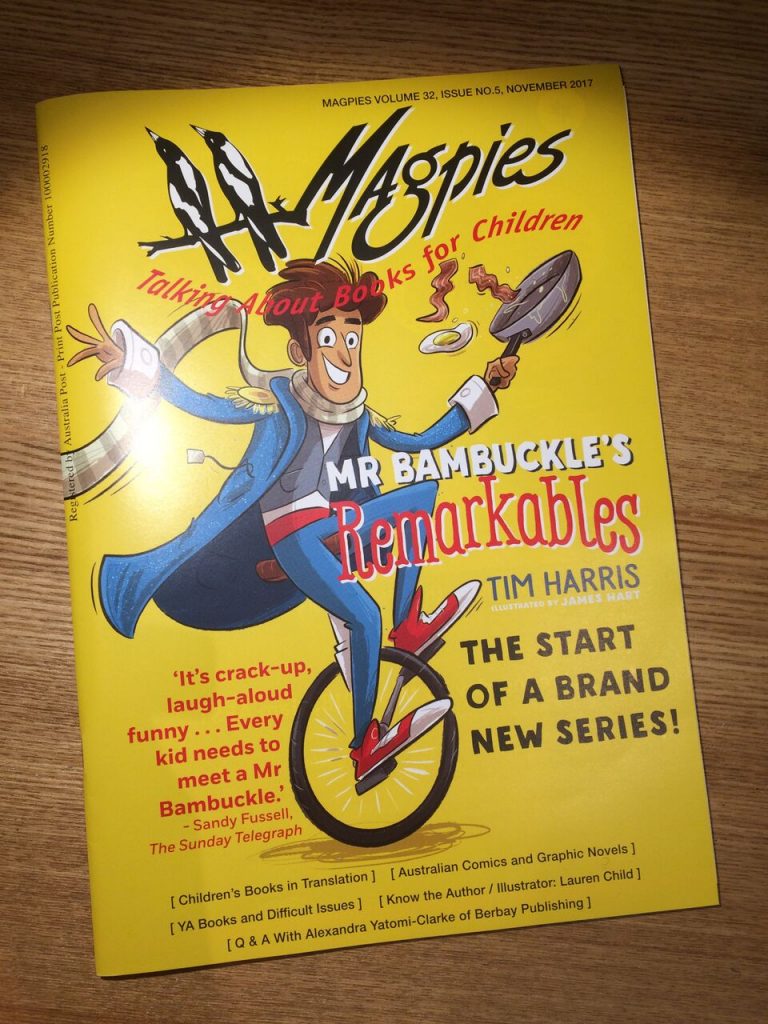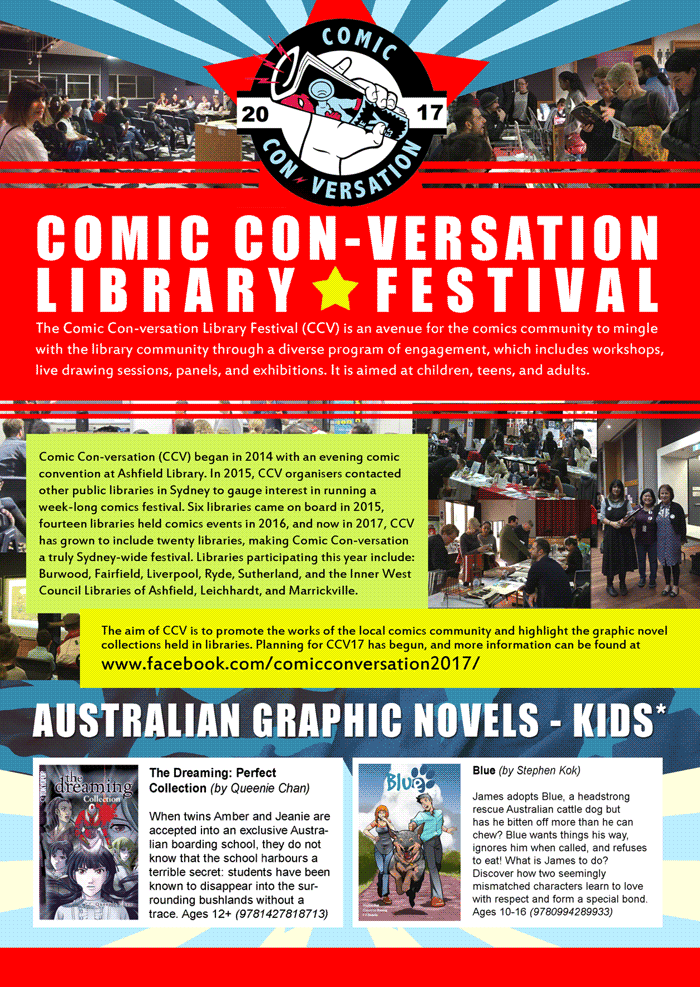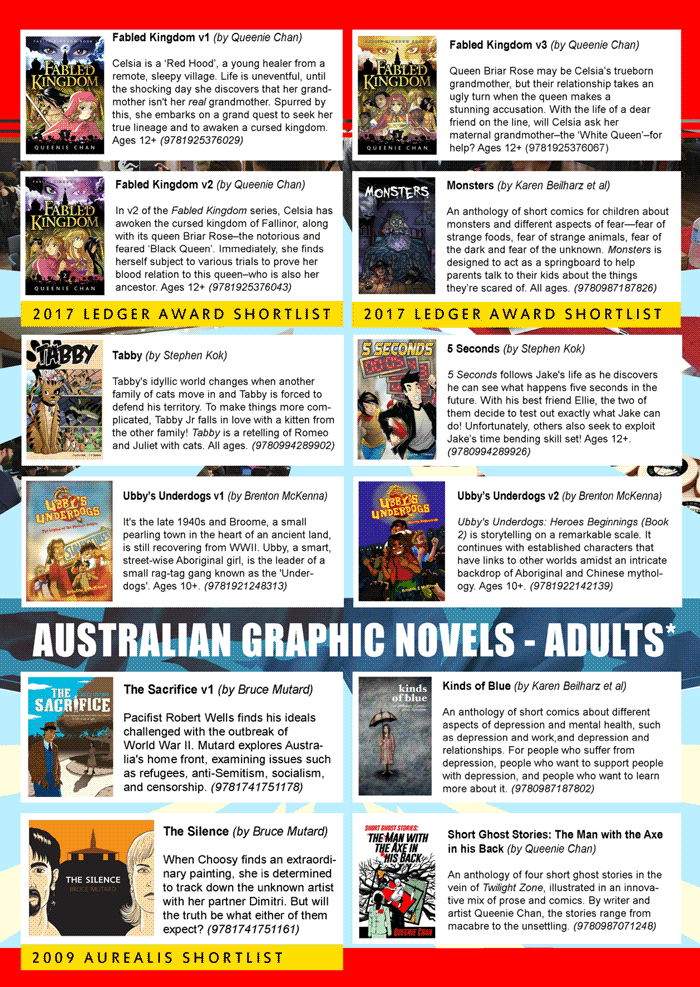This article was originally written for Magpies Magazine Vol 32, No. 5 (November 2017). Magpies is an Australian magazine for school and public libraries that deal primarily with children’s literature. The purpose of writing this article was to raise awareness for Australian comics in local libraries.

![]()
Comics and Graphic Novels have become a major part of the literary landscape in the past 10 years, with demand driving many libraries and schools to establish a graphic novel section. Much of the growth is being driven by Asian and North America publishers and creators, but what about Australian graphic novelists and comic creators?
Comic Con-versation: A Library Festival
When librarian Karen Dwarte decided to hold an evening comic convention at Ashfield library in 2014, she was surprised by the enthusiastic response. The positive feedback led her to establish the annual library festival Comic Con-versation, an event that has grown to include 20 Sydney libraries in 2017. ‘The graphic novel section has been the most popular section for a while now,’ says Karen. ‘The festival has also grown quickly, and I continue to get expressions of interest from other libraries, including from Melbourne and Brisbane.’
The festival is a week-long celebration of Australian comics, consisting of talks, panels, workshops, art markets, and comic labs (where creators draw comics in the library and invite patrons to participate). It makes a concerted effort to promote the work of local authors and artists, and attracts a number of children, teens and adults interested in comics—of which there are many.
‘The interest of teens in comics-related activities is especially heartening,’ says Karen. ‘Teens have traditionally been a difficult demographic for libraries to attract, and the trends show that inroads are being made.’
About Australian Graphic Novelists
For the longest time, the majority of comics sold in this country tended to be foreign. They were typically superhero comics from America, or more recently, manga from Japan. Despite this, Australia still manages to have a long history of independent work, and its best local cartoonists have always been as distinct and entertaining as their international counterparts. This country boasts a breadth of material, ranging from the vigilante action hero ‘The Phantom’ to comic strips like ‘Ginger Meggs’. It also includes the work of cultural commentators such as Michael Leunig.
This is a proud tradition that still holds, whether we’re talking about artists or writers working for American comic publishers like Image, Top Cow or IDW (their nationality rarely noted), or independent work printed for a local readership. Either way, Australian comic creators face the same problems as Australians in all areas of art: a small, fragmented market dominated by countries with more established industries and larger cultural footprints.
As such, self-publishing is the norm for a lot of local graphic novelists. This is hardly new for comics as a medium—for decades, underground comic book creators of more esoteric, experimental fare such as Robert Crumb and Art Spiegelman have self-published. The work of these men has been ‘rediscovered’ and lauded as art in the 21st Century, but the growth in popularity of comic book movies in the new millennia has seen a surge in public awareness. This has led to an influx of young people as well as more diverse voices, including women, people of colour, and LGBT creators.
According to a 2015 survey (Part 2, Part3) conducted by Julie Ditrich of Comics Mastermind, the average Australian comic creator is a white male (80%), who creates work for both genders aged 16+ (55%), and practices his chosen vocation as a hobby that earns less than $5000 a year (74%).
Interestingly, while 37% of respondents claim to work in ‘all ages’ comics, only 3% and 5% produce work for the 5-12 and 13-16 age ranges respectively. From this, it would appear that the old adage of children’s fiction lacking prestige holds true in comics too, though the survey also notes that 58% of respondents have seen an increase in their comics income in the past five years. This figure seems to indicate a growing market and appetite for locally-produced work, which is promising.
Marketplaces for Australian Comics
As mentioned, the popularity of superhero movies has raised the cachet of comics to the general public. Nowhere can that be more keenly felt than at pop-culture extravaganza events like Supanova, Oz Comic-Con and SMASH!.
Comic conventions may have originally been an American phenomenon—where fans of a particular subculture gather to celebrate their interests—but since the birth of the Internet, fan hysteria over a hit TV series can now travel across the world at warp speed. Men and women of all ages now gather on Twitter to dissect the latest movies, Snapchat pictures of cosplay competitions and dance-offs, and descend upon Artist’s Alley at comic cons to buy merchandise and fanart.
It is from these Artist’s Alleys where many Australian comic creators display and sell their work to the public. Whether they’re large scale conventions or smaller events focussed on small press publishers (such as MCA Zine fair, Otherworlds Zine fair, ComicStreet, Indie Comic Con, Impact Comics Festival, ZICS, ACAF and many more), each attracts a specific type of audience with particular interests. Other events such as ComicGong, Goulburn Comic-Con, Manly Zine Fair, NexusCon, and Comic-Conversation occupy a similar space, though these tend to be community events run by local libraries and councils rather than small press creators.
Alternative venues for sales are also growing. Writers festivals, such as this year’s Bendigo Writers Festival, are beginning to take an interest in comic creators for workshops and talks. Likewise, art galleries are also taking an interest in comic art – Liverpool City Library has held yearly comic exhibitions starring local creators, while Artshine Gallery in Sydney is hosting an annual exhibition by members of the Sydney Comics Guild. Sales figures from these events can vary wildly depending on the creator, though it points to a burgeoning culture that occupy real-world as well as virtual spaces. As with books, selling comics through the internet is common these days, with websites such as the Amazon-owned Comixology allowing self-published comics alongside professionally-published ones.
Australian creators have a global reach with these services, as they do with social media platforms where colourful illustrations remain highly popular. However, despite the ubiquity of such e-services, e-sales of comic book sales are believed to be only 10% of total comic sales, compared to 25% for e-books. This suggests either a readership with a preference for the physical edition, or just as likely, rampant internet piracy.
If hard copies of comics are preferred, then what about more traditional venues of book sales? Are there viable retail locations for Australian creators to ply their work outside the online or convention circuit?
The Comic Book Store
The idea that traditional bookstores have been struggling in the new millennium isn’t news. On the other hand, more niche outlets such as comic bookstores have been thriving.
In the past ten years, comic book stores have expanded the range of products they offer, from comic book ‘floppies’ of the latest X-men, to fully bound, beautifully-printed hardcover graphic novels. Rows of merchandise, models and T-shirts of every popular franchise ranging from ‘Star Wars’ to ‘Doctor Who’ are prominently displayed, along with multiple tie-ins of their comics and adaptations. However, the subject of our interest is their section for Australian comics—which may or may not have its own dedicated shelf in such spaces devoted to pop culture.
When there are more comic bookstores now than there were two decades ago, it was customary in the 1980s for a local store to have a shelf dedicated to Australian work. Nowadays, a cursory examination of different comic bookstores can tell varying stories about their relationship to locally-produced comics. Since comic bookstores operate like independent bookstores (despite having drastically methods of ordering, inventory management and customer relations), it can be said that each bookstore’s attitude to Australian comics is dependent on that of the staff.
‘Some of our local titles have outsold comics like Batman or Spiderman; we believe the connection between these stories and our customers is strong because they’re more relevant,’ says Mark Selan of Greenlight Comics in Adelaide, who devotes a section of their store to locally-produced work. ‘Dan McGuiness and I used to be in small press, so helping out as retailers seems right. We support the local community because they’re engaged and vibrant, with great potential.’
However, local creators can do more work on marketing. ‘In my experience, the creators who have business skills are the ones who sell the best,’ says Stephen Ford, a former employee of Kings Comics in Sydney. ‘I championed Australian comics at Kings Comics, but there is a limit to how much I can do. When a creative team puts money and effort into promoting their work, they can do very well.’
This isn’t a problem unique to comics. As the publishing industry fragments due to new technologies such as e-books and print-on-demand, all entrepreneur-artists can do with better self-promotion. However, few artistic types have the skillset to handle both the creative and the business side of their work, which is why publishers exist in the first place—to serve those needs. With the boom in graphic novels, you might think that publishers, with their wide-reaching distribution networks, would take a bigger interest in comics.
Unfortunately, Australian publishers are not known for publishing a lot of graphic novels. However, the reason may not be what most people think.
Australian Publishers and Comics
The best-known graphic novel published by an Australian publisher is probably ‘The Arrival’ by Shaun Tan, a stunningly illustrated, wordless comic centred around themes of immigration and displacement. It was published in 2008 by Lothian Books in Melbourne, an imprint of Hachette Australia. It won multiple awards, and after that, it ended up in the children’s picture book section of most bookstores, where it still occasionally resides today. This placement may have limited its audience and reach, especially when the intended audience isn’t necessarily children, but there were good reasons for that. A decade ago, graphic novel sections didn’t exist in a typical Dymocks—only in Borders, and certain independent bookstores. Certainly, things should have changed a decade later?
Fast forward to 2017, where ‘Small Things’ (published by Allen & Unwin) wins the Gold Ledger Award, the Australian industry awards for excellence in comics. ‘Small Things’ is a heart-breaking and sumptuously illustrated, wordless comic about childhood depression, and after winning multiple awards, it…ended up in the children’s picture book section. This is despite it being clearly a graphic novel and not a picture book. Some people might chalk its placement up to ignorance, but that isn’t entirely accurate.
‘I’ve been told by an Australian publisher that if I wanted to submit a comic, it’s best to pitch it as a picture book for children,’ said Doug Holgate, a Melbourne children’s book illustrator and co-creator of ‘Clem Hetherington and The Ironwood Race’ (due 2018 from Scholastic Graphix). In other words, Australian publishers do know the difference between a picture book and a graphic novel, but they deliberately mislabel graphic novels as picture books.
A burning question arises: Why?
The easiest explanation is that the average Australian bookstore, be it a Dymocks or a smaller chain, still doesn’t have much of a graphic novel section in 2017. For that reason, an Australian publisher trying to push a graphic novel may run into difficulty with book buyers who simply won’t stock a comic for lack of a proper section in their stores. Conversely, picture books will always be stocked, since picture books are a known category that will still make money despite the failure or success of an individual book.
It may sound lazy, but both bookstores and publishing houses are businesses. Where a book is stocked in a bookstore can determine its sales trajectory, and as such, mislabelling the category of a book is probably just a business decision, nothing more.
The Traditional Book Store
This strange situation isn’t helped by lack of reliable data. Bookscan data from the US shows Graphic Novels to be the only category to grow year after year for the past decade, but since graphic novel sales in Australia are mostly sold online or in specialty stores, exact figures are difficult to collect.
It doesn’t help that a sizeable portion of comics—22-page ‘floppies’ that many American publishers still publish in—lack ISBNs. These are considered periodicals, not books, and so these comic sales can’t be tracked using the same systems that track books. Not all buyers of ‘floppies’ go on to buy collected trade editions of the same story, but these sales can’t be easily ignored either.
‘Floppies’ aside, however, some traditional bookstores do quite well with graphic novels alone.
‘The Manga and Graphic Novel section of the bookstore has been the best-selling section for years,’ says Chew Chan, the Comics consultant for the Japanese chain bookstore Kinokuniya in Sydney. A hangout for all things hip, the bookstore has had a well-stocked graphic novel section since its opening in 1996.
The only chain bookstore that stocked comics in this country was Borders, and after it went bankrupt in 2011, it has only helped bookstores like Kinokuniya. As an industry, however, bookstores are embattled. Fads such as the colouring book craze aside, there has been no monster-selling book in the past few years to pull bookstores out of their retail slide. Even without the looming spectre of Amazon entering the Australian market, rising rents and runaway overheads have caused the bookstore market to contract.
This long-term, pessimistic outlook means that the motivation for the Dymocks chain to create a graphic novel section just isn’t there. New book sections require breadth of selection, shelf space, and knowledgeable employees, and the monetary returns are too uncertain for them to bother. Besides, it’s also too late—by now, most Australian consumers of graphic novels have already have been trained to either go online or to specialty stores to get their fix.
This situation definitely doesn’t help Australian publishers sneak comics into bookstores, but it would be wrong to say that comics hasn’t already been successful in Australian bookstores. Mislabelling comics as something else is already a very profitable business—and I don’t mean putting popular cartoon strips like ‘Dilbert’ into the humour section either.
Wimpy Kids and their Clones
Spend ten minutes in the middle grade section of a typical bookstore, and you will realise that the ‘Diary of a Wimpy Kid’ series by Jeff Kinney is extremely popular. It has spawned legions of clones, including some wildly successful Australian ones, like ‘The 13-Storey Treehouse’ series by Andy Griffiths (illustrated by Terry Denton), and the ‘Weirdo’ series by Anh Do (illustrated by Jules Faber).
These books are international million-copy sellers with their mix of humorous prose and cartoony doodles, and while most people don’t consider them comics in the traditional sense, you cannot discount the fact that their success rests partly on their illustrations. Which is where the crux of the argument lies, even though pictures in children’s books are as old as the category itself.
Only a generation ago, illustrators such as Quentin Blake would have been labelled ‘children’s book illustrators’ with nary a raise of the eyebrow. This new crop of illustrators, however, prefer to self-identify as ‘cartoonists’ or ‘comic book artists’. Jeff Kinney has clearly said that he wanted to draw comics, but lacked the technical skills, and so ended up creating ‘Diary of a Wimpy Kid’ instead, a book that was originally intended for an adult audience. No matter the aesthetic, the way that these artists see themselves has undergone a subtle but important shift.
If the artists who work on these books see themselves as ‘comic book artists’ rather than ‘children’s illustrators’, then shouldn’t these books be considered comics?
A Peculiar Legacy
That’s a question with no clear answer.
A few decades ago, promoters of the comics medium like Scott McCloud (‘Understanding Comics’) may have been thrilled to see comics treated as commonplace in bookstores, rather than being segregated into a separate, dimly-lit corner.
However, what McCloud envisioned was a cultural shift that treated comics like ‘Maus’ or ’The Sandman’ as serious adult literature, not full-spectrum dominance in the ages 9-12 section. The roaring success of children’s comics in 2017 is great news, but not necessarily something the average comic book creator celebrates with unbridled glee.
Still, we continue to push forward, finding new audiences and converts every day like any growing subculture would. This new interest in graphic novels from libraries is a frontier that was unthinkable only a decade ago, and so a concerted effort took place this year to get more Australian comics listed with library suppliers such as James Bennett and the ALS.
‘Getting Australian graphic novels with library suppliers have made it a lot easier for libraries to support Australian creators,’ says Karen. ‘Suppliers have also become more aware of the category. When I first started Comic Con-versation, it was very difficult to buy Australian comics for the library because of the paperwork involved. Now, I can order it with my supplier and have it already catalogued when it’s sent to us.’
Comic Con-versation Comics List
2017 saw the first effort to create a graphic novel purchasing list for the libraries participating in Comic Con-versation. Below is a list of Australian graphic novels for both children and adults that are available to order from library suppliers. Click here to download it as a PDF.


